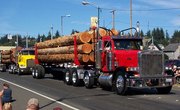The lumberjacks of the 1800s performed their difficult and dangerous work without any of the conveniences of modern technology. Instead of chain saws, they used axes and long, flexible saws known as "misery whips." Daily pay of around $1.25 and tools such as steel wedges, wooden mauls, sledgehammers, and log-moving tools like chains and greased skids, made logging a perilous -- and underpaid -- profession.
Logging Axes
Lumberjacks used two types of axes in the 1800s: a single-bitted or single-headed axe and a double-bitted axe. Some loggers believed the double-bitted axe to be a dangerous choice, and preferred to use two single-bitted axes instead. They would use one axe to get through the bark and the second for the tree itself.
Misery Whips
Up until the 1880s, lumberjacks felled trees with axes. The custom of using the cross-cut or "misery whip" saw began in Pennsylvania and spread from there. The unhappy name for this tool comes from the difficulty and frustration of using a saw that they could not keep sharp enough. Misery whips came in a variety of sizes, depending on the tree to be cut down. The saws ranged from the one-man saw (which could be as short as three feet) to the two-man saw (which could be as long as 16 feet). Felling saws were the flexible and relatively light saws lumberjacks used for cutting the trees down. Bucking saws were the heavier and less-flexible saws used for cutting logs on the ground.
Wedges, Mauls and Sledges
The 1880s brought not only the cross-cut saw into the logging business, but also the steel wedge. Prior to this, the lumberjacks used old pole-axes as wedges. The steel wedge was much more effective, but the traditional wooden mauls would bounce off the wedge so lumberjacks replaced them with sledgehammers.
Moving Logs to the Sawmill
Before the invention of motorized logging equipment, lumberjacks moved logs through the forests by teams of cattle. They pounded "dog hooks" into the ends of the logs so they could be chained together. Then they rolled logs onto greased skids, pulled by teams of bulls to the edge of the river where the logs were stacked up in gigantic piles. When it was time to move the logs to the sawmill, the piles would be knocked into the river to float downstream. Men called log drivers kept the logs from getting bunched up by using pike poles. These were poles of between 16 and 25 feet long, with hooks on the end for maneuvering the logs.
Related Articles
References
Writer Bio
Scott Thompson has been writing professionally since 1990, beginning with the "Pequawket Valley News." He is the author of nine published books on topics such as history, martial arts, poetry and fantasy fiction. His work has also appeared in "Talebones" magazine and the "Strange Pleasures" anthology.











